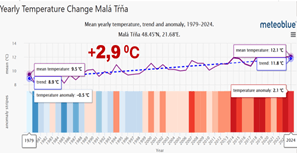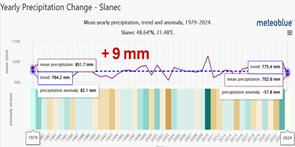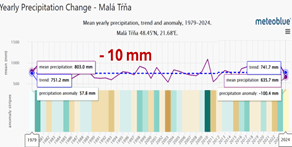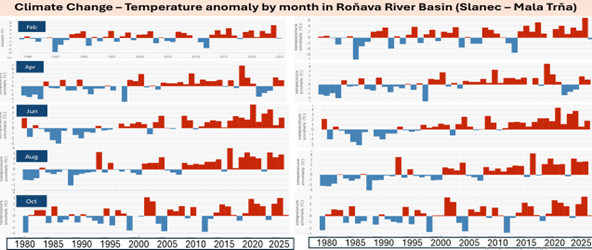
We forgot about water in landscape planning and that's why our landscape is overheating
For territorial development, rainwater was a nuisance that public policies tried to remove from ecosystems as quickly as possible from areas that were used economically by humans. The largest interventions in the Slovak landscape were oriented towards the drainage of agriculturally used land. These simplified ideas of land use led to mass drainage, especially of arable land. The territory in which the Roňava basin is located belongs to the territory of the East Slovak Lowland and is one of the most industrialized areas in Slovakia.
Over the past 50 years, average annual temperatures in the upper part of the basin (dominance of forest ecosystems) have increased by 2.7 degrees Celsius. In the lowland part, temperatures have increased by up to 2.9 degrees Celsius.


This increases the risks to agricultural crop production, mainly because as temperatures rise, the need for water increases, which tends to decrease in open agricultural landscapes.


The estimated moisture content already reaches around 300 mm per year (3,000 m3/ha). Spatial changes in the distribution of precipitation in the future will further increase this trend. This is confirmed by a more significant trend decrease in precipitation within the East Slovak Lowland.
It is also very important to know the temperature anomalies during the year in order, for example, to grow crops that are sensitive to the temperature regime of the country and can withstand dramatic weather changes (for example, pears, apricots, peaches). Longer periods without frost cause the early onset of tree flowering, which, with subsequent spring frosts, threaten the freezing of tree flowers (see the development of temperature anomalies mainly in the winter and with the onset of spring in the lowland part of the territory). These risks can be prevented strategically if there is more water in the structures of the country, and this is about water planning directly on the economically used area. The framework analyses show that it is necessary to strengthen the introduction of solutions close to nature into the agricultural landscape in any farming, which will naturally strengthen the thermoregulation of the country.

It is quite risky to grow fruit products on a farm that lacks water. Thermal imaging shows that the temperature of the earth's surface on May 1 exceeded 40 degrees Celsius.

In the agricultural landscape of the Roňava river basin, it is necessary to increase the annual balance of water reserves by at least 3,000 m3. This is what the scientific research project of the LAND4CLIMATE consortium, of which the NGO People and Water is a member, is trying to solve.
This article was written by Michal Kravčík from LAND4CLIMATE consortium partner NGO People and Water.
Publishing date:
